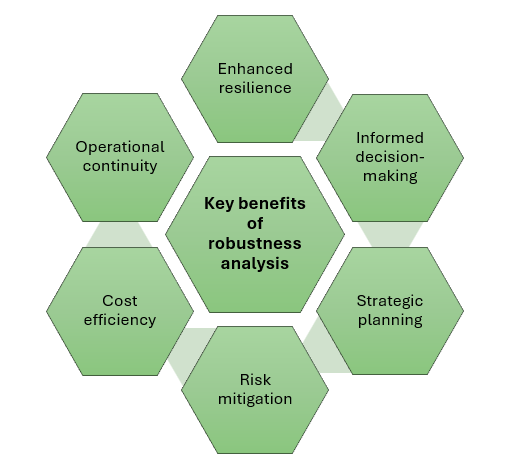Robustness analysis: future-proofing terminal design against uncertainty
Introduction
Container terminals come in various shapes and sizes. From enormous marine terminals operating a large fleet of automated equipment, to small inland terminals using flexible, manned equipment. Throughput volumes ranges from a couple of thousand containers and can grow to over 10 million TEU per year per terminal. Despite such rich diversity, we typically look at least 10 year ahead when designing terminals. This thorough approach sounds perfectly logical, as from planning to construction usually takes several years and investment costs are high.
Because of the long-term nature of the planning endeavour for terminal design, robustness to change is absolutely essential. Incidents such as natural disasters and international conflicts and longer term market changes often lead to unpredictable shifts in demand and supply. Assumed values may prove to be inaccurate, and estimations may turn out too optimistic or pessimistic. Although these deviations are inevitable, they should ideally not invalidate the design of the terminal . The outcome of a careful planning exercise will not maximise throughput for one specific set of assumptions, but it should meet requirements across a wide range of possible future scenarios.
Planning that meets future demands despite not knowing the exact future!
Definition
A terminal design is considered robust if undesirable but reasonably likely deviations in design parameters do not significantly impact the terminal’s throughput and performance objectives.
Method
Traditionally, we fix input assumptions and seek the maximum achievable throughput volume. In our method to future-proof terminal design, we “fix” the target volume and investigate the effects of deviations in key design parameters.
The next step involves identifying critical design parameters and determining the extent to which they could deviate from their initial values in an undesirable direction. Using the analysis and simulation tools at Portwise, we assess the impact of such deviations on different parts of the terminal, including waterside, yard, and gate operations.
Case study
In a case study , the method is applied on an actual container terminal by looking at its waterside and yard operations. The case study is based on a design project made by Portwise for an automated container terminal, which aimed to increase the throughput volume by 50%. The terminal design is considered robust if reasonably likely deviations in design parameters do not significantly impact the throughput and performance objectives, compared to the base case.
We analysed four different parameters impacting the berth capacity of the terminal. In this example, the terminal’s berth can support the target volume even when:
- 10% lower QC productivity,
- 10% increase in arrival delays,
- Up to 1m higher vessel drafts,
- 10% higher seasonal peak.
Impact levels
Green: Negligible impact – robust
Yellow: Some impact – still robust
Red: Significant impact – not robust

The yard storage capacity can support the target volume without major issues under:
- 15% lower QC productivity,
- 9% more volume during peak times,
- 10% longer dwell time.

Conclusion
This robustness analysis offers crucial insights for evaluating various terminal design options, allowing for the development of a system that is both optimal and resilient. By understanding how different parameters can deviate from their expected values and still support the targeted throughput and performance levels, terminal operators can future-proof the design of their facilities and are better equipped to handle unforeseen events.
Key benefits of this approach include:

In summary, robustness analysis is not just a tool for assessing terminal design; it is a strategic imperative for future-proofing operations. By adopting robust planning principles, terminal operators can ensure that their facilities remain resilient, adaptable, and efficient, safeguarding their investments and maintaining operational excellence in an uncertain world. This forward-thinking approach positions them to handle future challenges with confidence, ensuring long-term success.